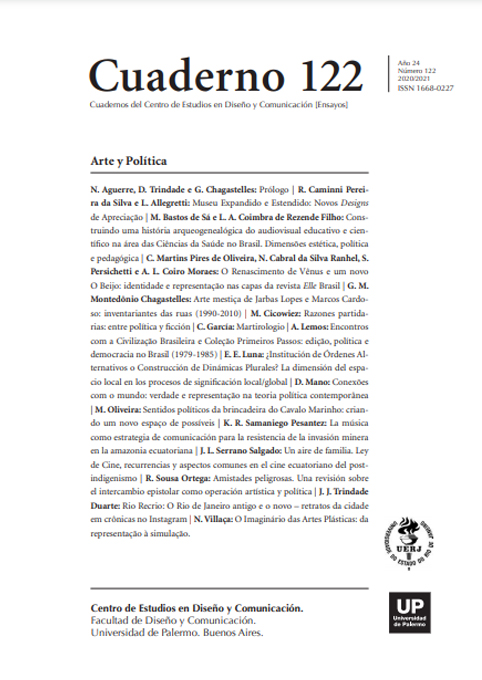Razones partidarias: entre política y ficción
Abstract
The analysis of the propaganda devices concerning an executive power electoral campaign is subsidiary of the recognition of the relation between Art and Politics. The proposed case study of the still and in motion images displayed by Cambiemos coalition in 2015 recaptures the contiguity between visual / audiovisual art, subject to an electoral communication strategy. Based on the selection of a number of images / samples, there will be an identification of the rule for forming canvassing operations whose reading contract establishes a political consideration, which has, however, drawn on a process of art and fiction production. This duality has not been exempted from concealing the subject from his enunciation in view of the presumed exhibition of the real thing without intermediaries. If art is no longer an eminently aesthetic creation, and is situated on the threshold of political action, in the same way, the governments preaching has created an indistinct zone in relation to art and its proclamation of party and electoral communication.
References
AA.VV. (2013). Estamos. Una invitación abierta. Peña, M.; y Rozitchner, A. (Compiladores. Prólogo de Mauricio Macri). Ciudad Autónoma de Buenos Aires: Editorial Planeta.
Benveniste, E. [1959] (1999). Las relaciones de tiempo en el verbo francés” (en línea). En: Semiosis, nueva época, Vol. 1, (5), pp.52-61. Recuperado de: https://cdigital.uv.mx/bitstream/handle/123456789/6624/19995P52.pdf;jsessionid=671B03C84E691143B5EB8D81EDB64E12?sequence=2
Bettetini, G. (1996). La conversación audiovisual. Problemas de la enunciación fílmica ytelevisiva. Madrid: Ediciones Cátedra, S. A.
Bourriaud, N. (2008). Estética relacional. Buenos Aires: Adriana Hidalgo editora S. A.
Carlón, M. (1994). Imagen de arte / imagen de información. Buenos Aires: Atuel.
Casetti, F.; y di Chio, F. (2014). Cómo analizar un film” Barcelona: Paidós.
Gubern, R. (1974). Mensajes icónicos en la cultura de masas. Barcelona: Editorial Lumen.
__________. (1987). La mirada opulenta. Exploración de la iconosfera contemporánea. Barcelona: Gustavo Gili, S.A.
Lipovetsky, G.; y Serroy, J. (2015). La estetización del mundo. Vivir en la época del capitalismo artístico. Buenos Aires: Editorial Anagrama.
Michaud, Y. (2007). Introducción. En: El arte en estado gaseoso. Ensayo sobre el triunfo de la estética (pp. 9-23). México, D.F.: Fondo de Cultura Económica.
PRO (s/a). (2015a). Con Nicolás en Entre Ríos. Vamos Juntos [spot]. Disponible en https://youtu.be/lnnpanZPRLQ
PRO (s/a). (2015b). Con Edelmira en Morón. Vamos Juntos [spot]. Disponible en https://youtu.be/esR9QUjn4bo
PRO (s/a). (2015c). Con Edelmira en Morón. Vamos Juntos [spot]. Disponible en https://youtu.be/esR9QUjn4bo
Verón, E. (1987). La palabra adversativa: observaciones sobre la enunciación política. En: AA.VV. El discurso político. Lenguajes y acontecimientos (s/n). Buenos Aires: Hachette.
__________. (2001). Interfaces. Sobre la democracia audiovisual avanzada. En: El cuerpo de las imágenes (pp. 41-66). Bogotá: Grupo Editorial Norma.
Los autores/as que publiquen en esta revista ceden los derechos de autor y de publicación a "Cuadernos del Centro de Estudios de Diseño y Comunicación", Aceptando el registro de su trabajo bajo una licencia de atribución de Creative Commons, que permite a terceros utilizar lo publicado siempre que de el crédito pertinente a los autores y a esta revista.


